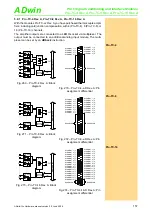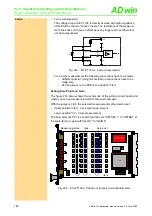
ADwin-Pro
Hardware, manual version 2.9, June 2006
151
Pro I: Digital-I/O- and Counter Modules
Pro-Storage Rev. A
ADwin
The SP writes the number of the saved values (write pointer) into the
file
Fileinfo.dat
each time when saving a complete sector is
saved. Upon restart the SP reads this write pointer and appends new
files.
• Duration of the time-out:
The time-out is the longest time interval, after which data from the
FIFO array are buffered (backup copy).
Normally the SP stores data, if it can write up to 128 values into one
or more (12) sectors. But if the time-out is reached earlier, all data in
the FIFO are saved immediately.
• Approximate size of the FIFO array for data transfer:
The array must be large enough to buffer fluctuations of the data flow,
e.g. when data arrives irregularly or if there is a delay when the data
memory is accessed (for hard disks see
A later adaptation of the process cycle times may require to change
the array size.
• Data type (FLOAT or LONG) of the data to be saved.
The SP can only be used for processing one of the two data types.
Which process starts?
2. Determine, which process is to start first (SP or MP). For both possibil-
ities the pros and cons have to be considered:
We assume that both processes are already on the
ADwin
system, but
have not yet been started. The process started first determines the basic
parameters. Either the first process or the PC start the second process.
Measurement process starts
+
Flexible
: If the MP starts the SP, it can re-define the number of the
destination file, the time-out and the write mode for the SP upon
each restart. Thus the MP saves the data in several files.
Therefore, if there are changes, the SP does not have to be com-
piled again.
−
Latency
: The MP must wait with the transfer of data into the FIFO
array until the SP reports that it is ready to save the data. Alterna-
tively the FIFO array can be dimensioned as buffer for this latency
and already receive data.
Normally the SP is interrupted by high-priority processes, so that
the latency cannot exactly be determined before.
+
Data loss preventable
: If the MP buffers more data in the FIFO
array than the destination file can take, the surplus data must be
written into another file, otherwise it is lost. For this the MP must
stop the SP and restart it with a new destination file number.
Saving process starts
−
Programming effort
: If the number of the destination file, the time-
out or the write mode are changed, the SP must be changed and
re-compiled.
−
Possible data loss
: If the MP buffers more data in the FIFO array
than the destination file can take, those data will be lost.
+
No delay
: If the SP starts the MP, the MP can pass the data into the
FIFO array without any delay. Also possible is to monitor the status
of the SP via PC and then start the MP.
−
Start time not determinable
: The time when the SP starts the MP
cannot exactly be determined.
















































